Bicentennial bells: Mokuaikaua Church celebrates 200 years

Mokuaikaua Church is surrounded by construction equipment on April 2. The church will celebrate its 200th anniversary on Saturday, April 4. Tom Linder/West Hawaii Today
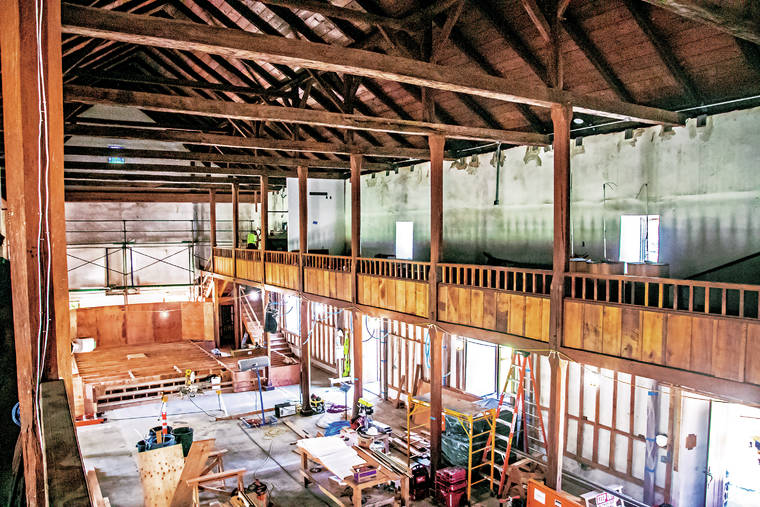
The partially-constructed altar of Mokuaikaua Church sits amid workers and machinery as crews work to complete construction. Tom Linder/West Hawaii Today
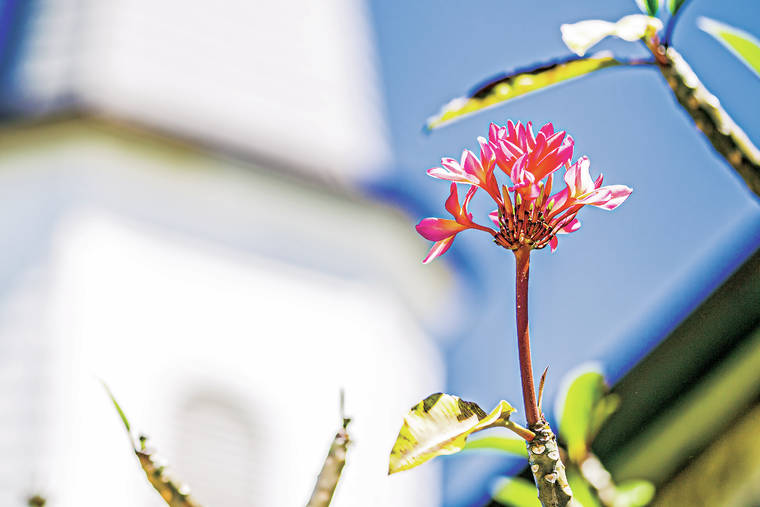
A single flower is perched in front of Mokuaikaua Church’s steeple. Tom Linder/West Hawaii Today
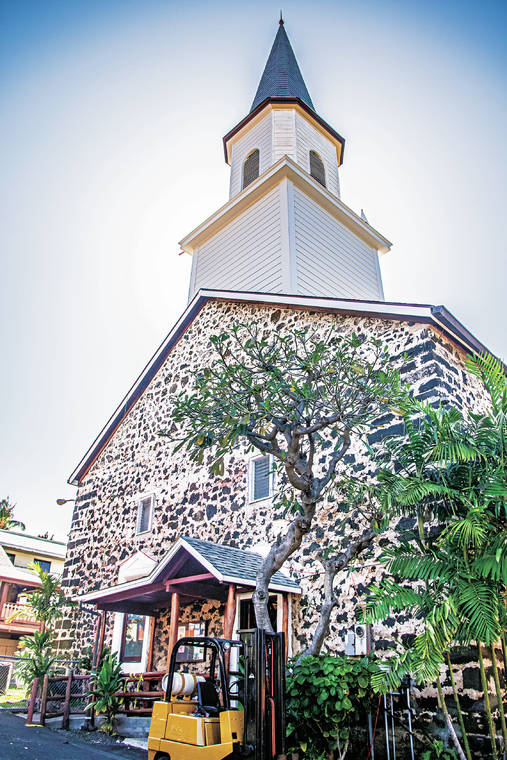
Mokuaikaua Church’s iconic steeple rises high in the Kona morning sunlight. Tom Linder/West Hawaii Today
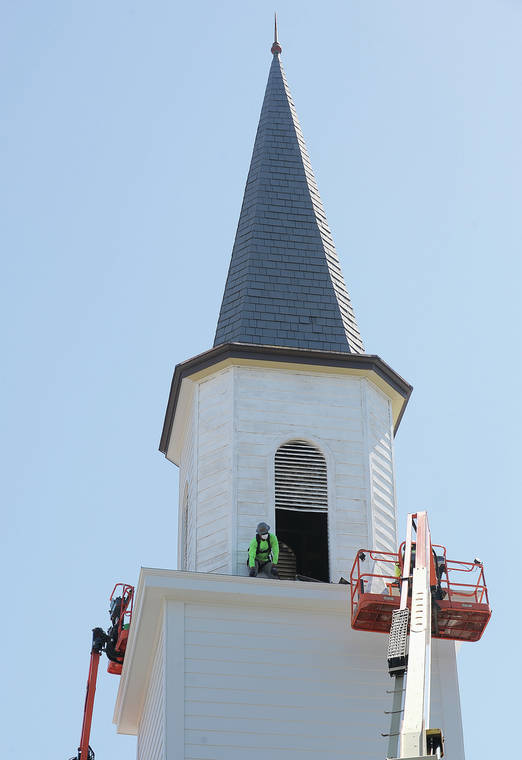
Workers restore the steeple at Mokuaikaua Church. (Laura Ruminski/West Hawaii Today)
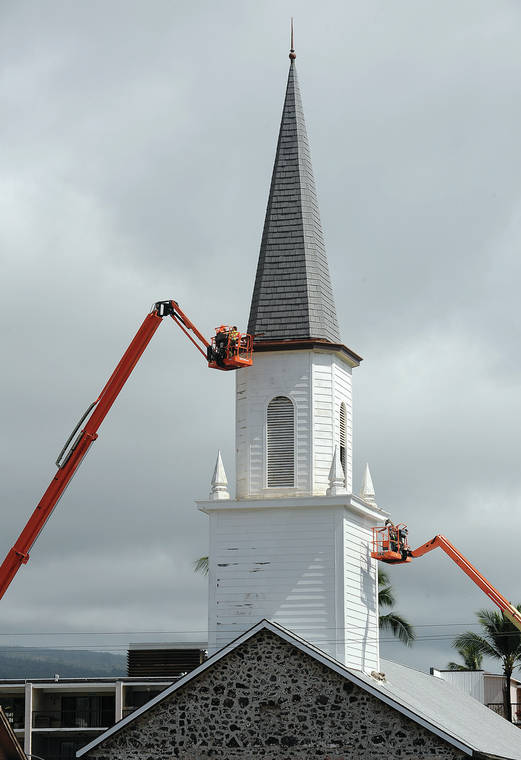
Workers restore the steeple at Mokuaikaua Church. (Laura Ruminski/West Hawaii Today)
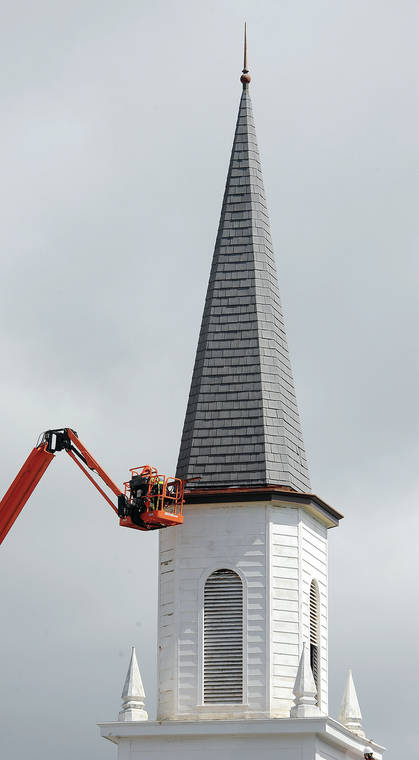
Workers restore the steeple at Mokuaikaua Church. The renovation’s pièce de résistance lies inside that steeple. After nearly a century of wear, the steeple – built in 1926 – has been restored and will house a refurbished bell: the same bell that has sat within the church since 1859. It’s been on a journey over the past few months after being shipped to the mainland for repairs. (Laura Ruminski/West Hawaii Today)
Kailua Village residents will be reintroduced to a once-familiar sound this morning when Mokuaikaua Church’s bell will ring 200 times.
Kailua Village residents will be reintroduced to a once-familiar sound this morning when Mokuaikaua Church’s bell will ring 200 times.
The Kona landmark and first Christian church in Hawaii marks its 200th anniversary today, venerating a congregation formed in 1820 by Asa and Lucy Thurston after reaching the islands aboard the first ship of American Christian missionaries, the brig Thaddeus.
“We’ve asked all our congregational churches and other churches that want to join us around the state to ring their bells 200 times,” Mokuaikaua Church pastor David de Carvalho said. “At 9 a.m., you’ll probably hear bells ringing; that’s just acknowledging 200 years of the goodness of God, of the arrival of the gospel here in Hawaii.”
The occasion is also a time for prayer, he said, especially amid the ongoing COVID-19 pandemic that has sickened more than a million and claimed the lives of thousands worldwide.
“We’re also asking for people to join us to pray,” de Carvalho said. “We ask that friends and churches from around the globe come together and pray that we see the end of this coronavirus.”
A planned celebration commemorating the anniversary, including a reenactment of missionary arrival, a parade and other festivities plus a luau and fireworks show that had been slated for today has been postponed due to COVID-19 restrictions. Social distancing has also taken its toll on the Mokuaikaua ohana; for the first time since missionaries arrived, the church’s congregation is not meeting at the church’s site for services.
But de Carvalho remains optimistic about festivities in the future.
“We had planned for the day of celebration; we were going to close the street, have activities here in the church and across in the palace,” de Carvalho said. “Then in the afternoon, we were going to have a big luau for 1,000 people, entertainers, so on, and fireworks at the end.”
The Mokuaikaua ohana still plans on holding a celebration when the coronavirus concern subsides, however.
“We will have our big celebration. We’re just waiting on dates right now…” de Carvalho said. “We’re up in the air right now as far as a specific date, but as soon as we can, we will celebrate.”
The pastor even sees a silver lining in the situation: their 200th anniversary celebration plans will hopefully coincide with a more than $4 million renovation of the church that’s expected to be complete this summer.
“That’s the idea right now — we will be totally done and it will be an opening of the sanctuary, celebrating the end of construction, ready to begin our services again,” de Carvalho added. “And at the same time, celebrating 200 years. That will be the cherry on top.”
The renovation project, which got underway in June 2019, is nearing completion of its second and final phase. The first phase addressed significant structural concerns – including three major cracks to the exterior stone walls sustained during magnitude-6.7 earthquake in October 2006 — and improved the church’s roof and ability to withstand future earthquakes and hurricanes.
The second phase consists of interior improvements including replacing ohia posts and beams, restoring walls and replacing electrical wiring.
Mokuaikaua’s original structure – using coral and ohia timber from Kona’s inland forests – was completed in 1837; 17 years after the Thurstons arrived from Boston. Nearly all of the original structure still stands to this day, a key point of emphasis during the renovation of the building that was added to the National Register of Historic Places in 1978 and designated as one of America’s 11 most endangered historic places by the National Trust for Historic Preservation in 2014.
At the start of the project, the renovation was estimated to cost $3.1 million, but that figure increased to more than $4 million as work progressed as issues and tasks came to light.
“You start into it and you know fundamentally what you’re trying to do, but you get into it and discover all kinds of new things,” said Board of Trustees chairman David Ross, noting how installing structural support for the steeple uncovered significant needs. “It’s like putting a skeleton inside of the church. … In the middle of doing that, it became clear that the weight of all that was showing some weaknesses in the vertical posts. It’s one of those things where you go, ‘Lord, we don’t really want to deal with this.’ You have a choice: face reality, like it or not… We talked about it and said, ‘This is going to happen once every 200 years; we can’t cut corners here.’”
The church struggled initially to cover the additional cost, but ultimately secured funding from the community, the Hawaiian Historical Society and grants, along with a significant donation from an unlikely source. Faced with a budget shortfall only months before the project started, Ross describes how their biggest donation arrived on Dec. 18, 2018, from Canadian donor Alan Quensel.
“I just got down on my knees and I said, ‘Father, I’m the chairman of the board of trustees. I’m supposed to have the answers for all this; the only answers I have are the ones you’ve given us. If we’re going to proceed, you’ve got to do something major,’” Ross said. “That was at 8:30 in the morning. At 10, pastor got a call (from Quensel). He said, ‘I was at your service on Sunday; I really liked the word you gave and the history talk afterward. Can I come see you?’ He came into pastor’s office at 2 (p.m.), spent an hour with him and when he was done, gave a matching gift of $450,000.”
Quensel later gave a second donation of $3 million, ensuring the renovation could be completed in full.
The renovation’s pièce de résistance lies inside that steeple. After nearly a century of wear, the steeple – built in 1926 – has been restored and will house a refurbished bell: the same bell that has sat within the church since 1859. It’s been on a journey over the past few months after being shipped to the mainland for repairs. It was last rung in January 2019.
“We shipped it to Indiana, and certain parts they actually had fabricated in Belgium just to match the original,” Ross added. “It came back last week.”


